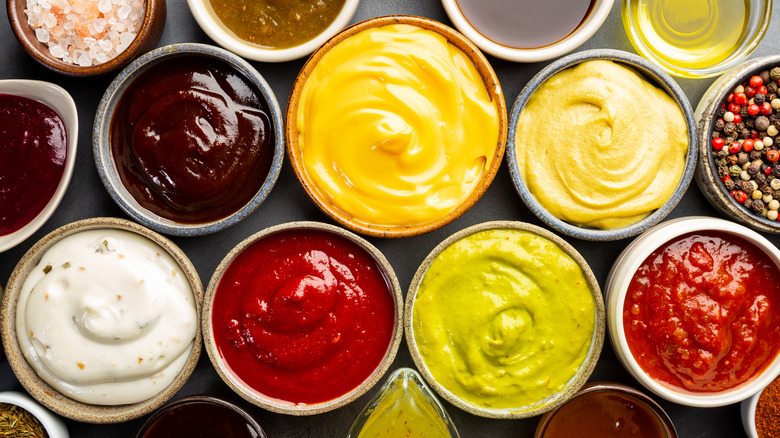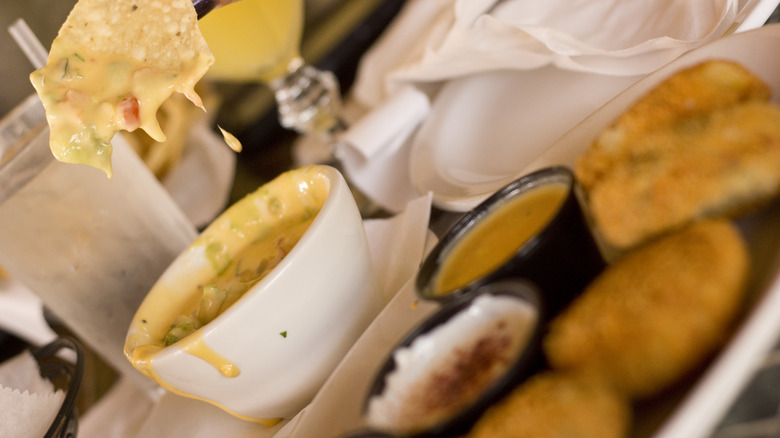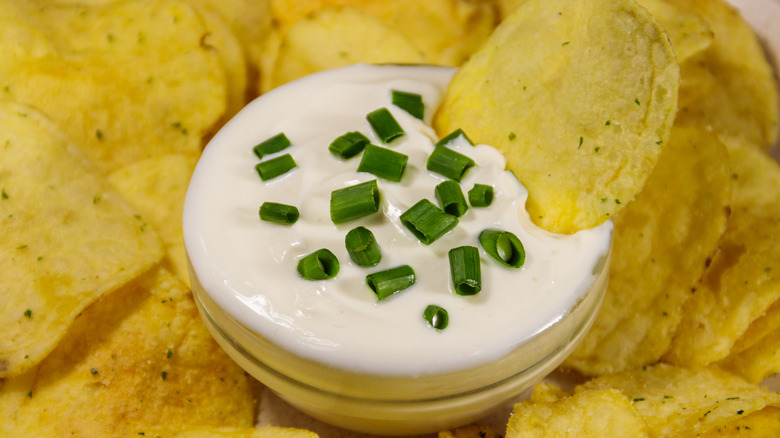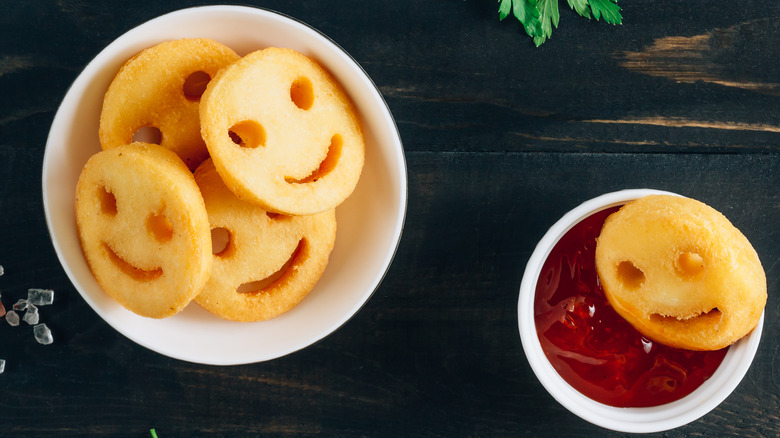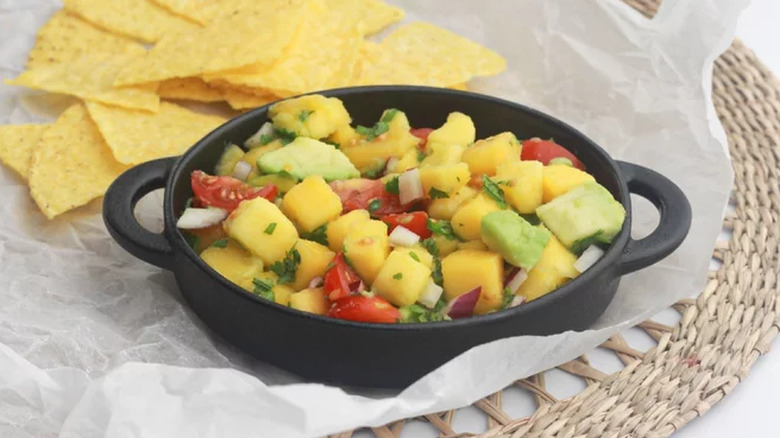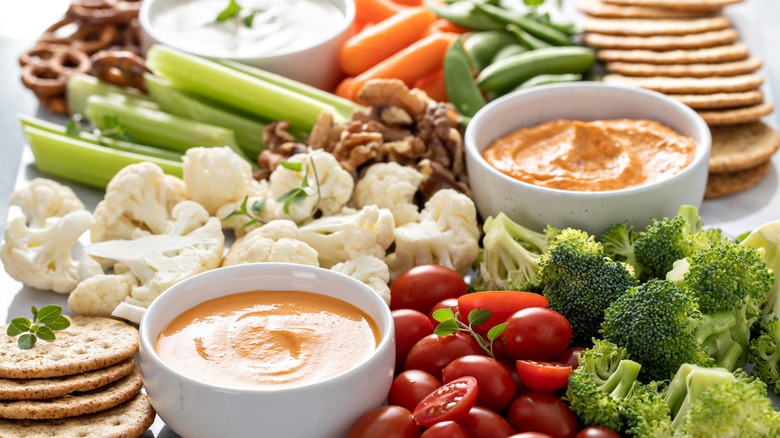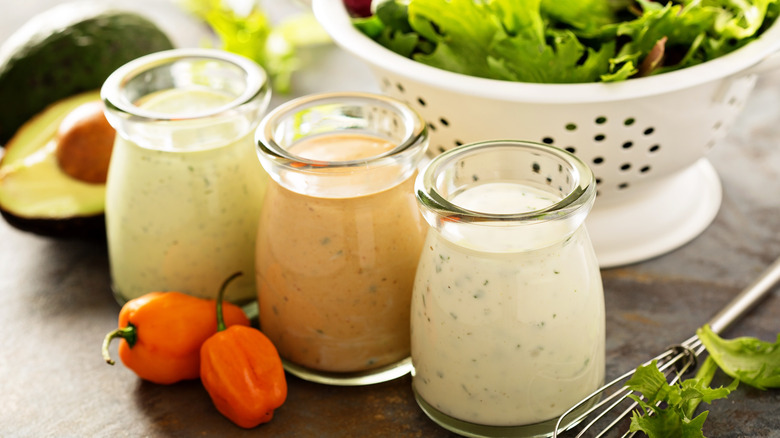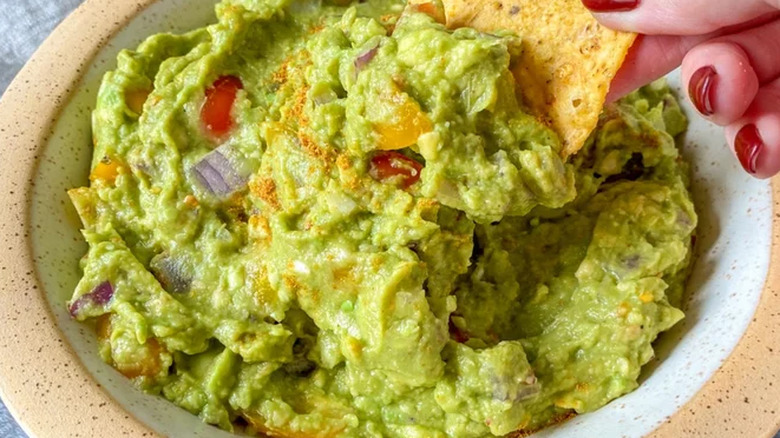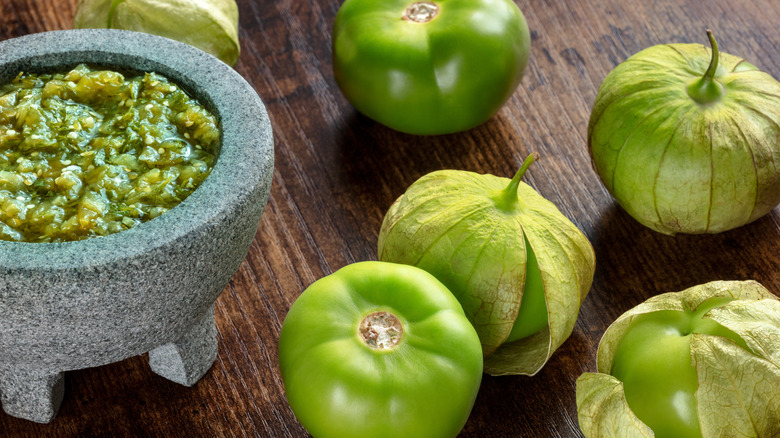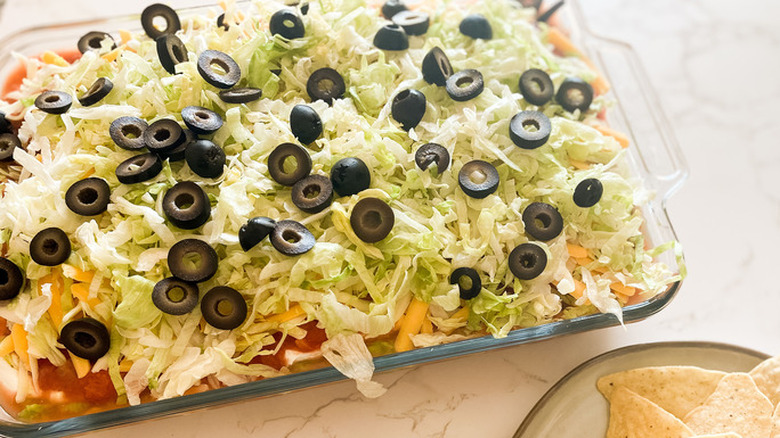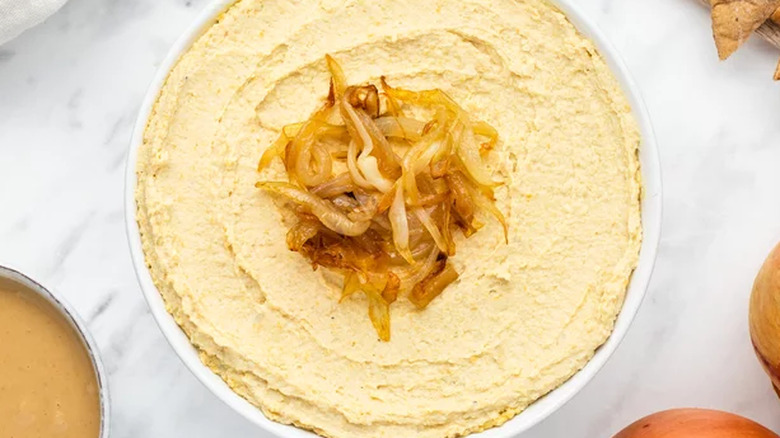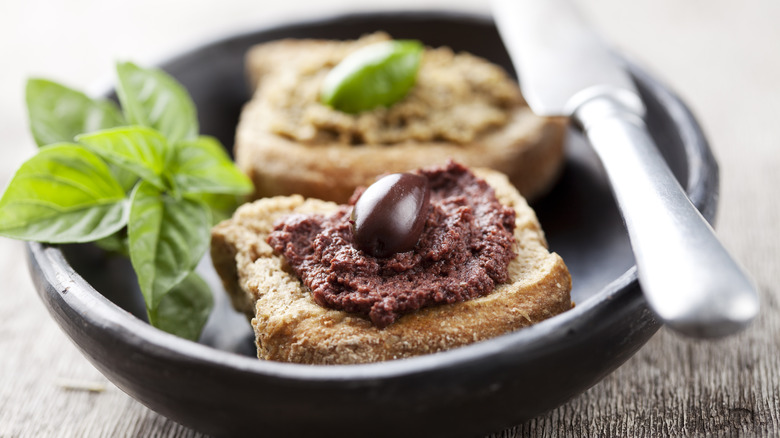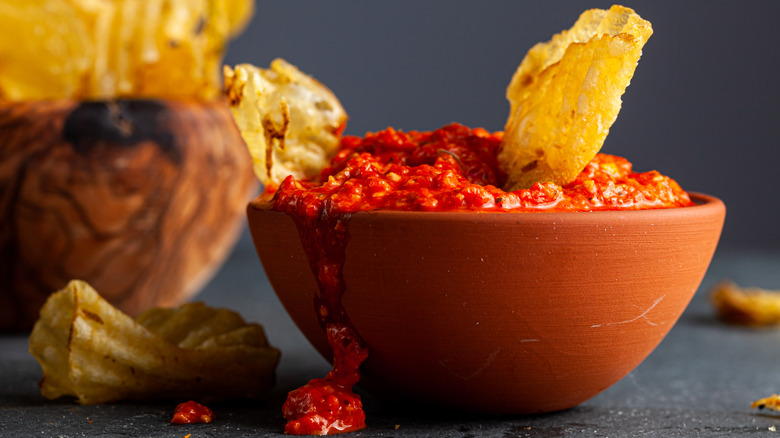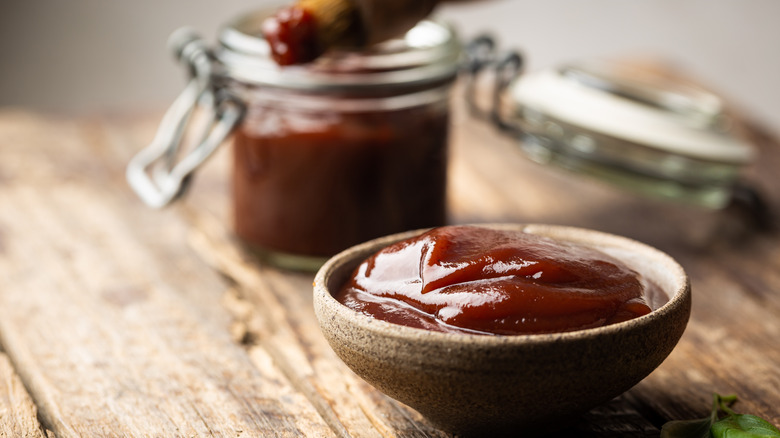Mistakes Everyone Makes With Homemade Dips
Whether you're chillin' watching the game or hosting a party, enjoyment is going to dip real fast if you serve bad dips. A greasy cheese sauce, a sour salsa, and a bland guac served with a few regular chips can dampen the atmosphere. Kudos if you make your own dips and shun store-bought jars. However, while most dip recipes aren't complex, issues can easily arise getting the taste and consistency right. You also need to think about what you're pairing with your dips.
Get it right, and you're going to be making your favorite dips at the drop of a hat whenever you can. Watching a movie, family time, or games night are all dip-tastic occasions. You can even serve a dip as a dessert, at cocktail hour, or to enjoy all alone. To help you along the way, here are some classic mistakes everyone makes with homemade dips — and how to avoid or resolve them.
Cooking an oily cheese dip
There're so many fancy-schmancy dips on the market with ever-more quirky ingredients. While these are fabulous for upgrading a soiree, sometimes you just can't beat basic over bougee. And there's nothing more simple than a cheese dip, but if you want to add some extra flavor, then why not make an easy beer cheese sauce with mozzarella and Cheddar for your next laid-back hangout? For game night, a meaty Rotel queso dip with Velveeta and chorizo is a heartier snack. Perhaps the easiest nacho-style cheese dip, showcased on TikTok, involves melting cheese singles in the microwave with a little milk. Anything with molten cheese is great — as long as it's not oily.
To prevent a greasy dip, follow each step of a recipe as if you're making a sauce such as making a roux. Once your roux is cooked through add milk, followed by the cheese. Don't overheat the dip once you've added the cheese, or it won't emulsify as well. Using cheeses that melt well also helps. Hard cheeses like parmesan don't work well in dips and sauces when melted. The good news is that American varieties are specifically made to melt well. You can also try semi-hard cheeses from other parts of the world, such as Gruyère. A good tip is to add sodium citrate, as this acts like magic and brings the emulsion together so amazingly that it creates a photoshoot-style glossiness.
Making a dip that's too thin
You're coolly chit-chatting at a group thang, and as you casually chomp on a chip, the dip drips. A thin dip is not only a potential social disaster, but it's messy. You need a good dip-chip ratio to achieve effortless dipping. It's not supposed to be a contortionist-style challenge to maneuver a chip into your mouth without the dip disappearing onto your shirt. You don't want to be digging into a dip that's too thick, but if it's too thin, then you need to thicken it up somehow. And remember, it's got to be the right consistency for whatever you're serving it with, as you can dip more than just chips.
Before you begin, you might want to use less liquid than a recipe suggests to begin with. That way, you can add more later giving you more control. Likewise, don't blitz it in a food processor but mash up a dip with a fork instead — otherwise it might turn into a thin puree. If it's too late, and you've already made a thin dip, then a good remedy is to add in some yogurt if your sauce is dairy-based to thicken it up. If you're making a spinach and artichoke dip, for example, throw in some more spinach or artichoke to add bulk. To thicken a cheese sauce, you can add an egg yolk while it's still cooking or some extra cheese.
Making a dip that's too thick
Ever stuck a chip into a dip, and it broke off? You might've then used another chip to try to salvage the original chip — only for that to be lost in the dip too. This rescue mission can be saved by serving a dip that's not too thick. Yes, you want the sauce to hold its own in just the right quantities on crudités. But a hot Maryland crab dip shouldn't have the consistency of wet cement. When you're happily heating a sauce to make a dip, keep in mind that once it's cooled, and refrigerated, those ingredients are going to thicken up.
The good news is it's pretty simple to thin out a dip. If you're making a cheese sauce, then dairy ingredients such as milk, cream, and melted butter will work. For other dips, you could add water or a spicy salsa if that complements the other ingredients. What about adding alcohol to a dip if it's one you prepare hot? Just make sure that it doesn't all evaporate off otherwise it won't loosen the dip up. Make sure anyone enjoying the dip knows it's a boozy one though when you cook with alcohol. The alcohol content doesn't reduce as much as you might think.
Pairing a dip with the wrong food
Unless you're having a strictly themed dinner party, many dips complement different dishes. That being said, pairing the right dip with the wrong food can challenge the taste buds. And not in a good way. A copycat Chuy's creamy jalapeño recipe is going to work with a Tex-Mex theme. Tzatziki with plates of kebobs is just so right. With the right pairing, a dip can elevate the other dishes. It's also great as an appetizer and whets the appetite with a palate of flavors to come.
A course that's often forgotten when thinking about dips is dessert. If you make a vanilla dip then taste-wise, and in terms of color, it's got to be served with something like berries and apple slices. A spicy dip isn't going to work with a delicate cordon bleu-style entrée. While a creamy dip might be a bit heavy if you're following it up with some Asian cuisine such as sushi. Make sure the dippers you serve pair well too. A thick dip needs more than a flimsy potato chip, whereas a bagel chip might be a bit heavy for a thinner sauce. A chunkier chip is needed for a hearty dip, whereas bread is great for a warm dip, and what about a vegetable chip for a velvety dip?
Making a salsa that's too acidic
If you get the right level of citrus, nothing is as refreshing as a salsa on a salty chip. Simple and fresh works, but if it's too acidic that sourness is going to hit hard as there aren't a lot of other flavors and ingredients to hide behind it. If you make our fresh mango salsa then you're going to need the juice of ½ lime with a couple of mangos and 10 cherry tomatoes. Usually, you spritz the juice on at the end and then stir it in.
If you add too much lime juice, then you might want to turn your dip into an ingredient to add to another recipe instead. That way, the acidity is canceled out. You could try adding in some sugar, baking soda, or even some grated carrot to balance the taste out. Although tomatoes are acidic, if they're roasted, they're sweet, so adding more of these might work. Another option is to add in some pulled pork as this tastes better with a more citrusy salsa.
Only serving chips with dips
If you're making a homemade dip, then it's a mistake not to consider what you're dipping. Chips are great, but what about crackers, carrots, fries, or pretzels? Bell pepper slices, fruit, and toasted bread are fabulous while cucumber, zucchini, and pickles add vibrant green goodness. If you love your veggies, then what about cherry tomatoes, broccoli, cauliflower, and sugar snap peas?
Tasty bites are perfect with dips too, such as buffalo cauliflower, shrimp, and nuggets. And what about bagel bites with an everything bagel dip? Serve up a platter of different foods to dip and pair them with the taste and consistency of the dip. For example, jicama is great with guac, and tortilla chips are ideal with salsa, and even better if you make your own. Roasted vegetable chips are a nice alternative to regular chips too. And if you want a more substantial snack, then dip mozzarella sticks, sausages, and rolls of cured meat.
Making a dressing not a dip
A dressing is great on salad but usually isn't the right consistency, texture, and flavor to be classed as a dip. However, you can make a creamy chip dip by combining cream cheese with French dressing, ketchup, and diced onion, for example. Ranch isn't a dip, per se, but you can transform it into a classic cowboy crack dip if you add it to cream cheese, sour cream, and shredded cheese with shallot and bacon bits. If you really want to separate this dip from the dressing that it's made with, then serve it hot so all those cheesy, herby flavors combine. Just cover it and pop it in the oven.
Are you grabbing the ranch and chips yet? You know you don't need a party to enjoy dips, right? A dressing often has a less punchy flavor than a dip. A blue cheese dip served with carrots, celery, and chips is supposed to have an intense flavor. A blue cheese dressing to toss salad leaves is likely to taste a little more subtle.
Letting your guac turn brown
Sometimes you just can't beat a bowl of guac and some chips. Yes, it's great to serve up when friends and family come over for drinks. But there's nothing better than a chilled-out night in front of the TV with a dip all to yourself, or perhaps to share with a loved one. The fresh flavor of the avocado with red onion, garlic, and cherry tomatoes is a hit that has a little heat making it beyond moreish. And is so scoopable with a thick tortilla chip. If you're one of those many that think that cilantro tastes like soap — it's genetic apparently — then make a herb-free guac. Whatever recipe you follow, the issue remains: How do you stop your guac from turning brown?
Tasting Table warns not to forget to add lime juice to the mix as this helps keep the fruit vibrant and green. When it comes to storing it, add a layer of olive oil that covers the top of the guac. This stops the air from getting to the dip and oxidizing it, which is what causes the brown color. You can then just pour the oil off and stir the dip when you want to eat it again. Other methods include adding a layer of water in much the same way. Covering with plastic wrap, adding the avocado stone to the dip, and covering it with the peel are other techniques you can try.
Taking shortcuts with ingredients
A dip can be an inexpensive way to offer nibbles or fill the gap between courses for hungry hoards. They're so quick and easy to make that they're a perfect shortcut snack to make in a hurry. However, as with any recipe, the end result is not only a reflection of your culinary skills but also the quality of the ingredients. If you want dippers to break out and sing Justin Bieber's "Yummy" when they taste your homemade salsa, don't make the mistake of not using the right tomatoes such as a Roma variety. Make sure to use fresh herbs too, and while red and white onions are a yes, brown onions are a no-go.
Since avocados are the main ingredient in guacamole, then don't ruin your guac by using fruit that's not ripe enough or in good condition. Olive oil creates a glossy finish while fresh lime juice and cilantro make this dip dazzle. When making homemade hummus, The Washington Post advises using chickpeas without the skins and adding generous amounts of a good quality tahini. Other tips include using super fresh garlic, freshly squeezed lemon juice, and extra virgin olive oil drizzled over the top rather than in the dip.
Not being adventurous enough
You only have to scroll through TikTok food pairing suggestions to understand that experimenting with food and flavors doesn't always pay off. However, playing it safe with the same, well-known staples can be a little bland. There's nothing wrong with a cheese dip, salsa, and hummus. The reason they're so popular is that they're yummy. But perhaps it's time to dive into the world of dips and explore some other cuisines.
If you love Mexican food then a tasty and attractive party dish is our 7-layer dip. It's so easy to make too, and there's zero cooking involved. The first layer is spicy cream cheese, refried beans, and sour cream mixture. Guacamole and tomatoes follow, then sour cream, salsa, and shredded cheese. Shredded lettuce is next with a sprinkling of black olives to finish it off. Serve with tortilla chips. Across the culinary map, you can embrace Asian flavors with soft shrimp spring rolls made from rice paper and stuffed with flavorful noodles. Serve with a dip made from hoisin sauce, peanut butter, water, and white vinegar. What about a Southern-style spicy remoulade? Or if you love eggplant dips then rustle up a kashk-e bademjan from the home of so many of the world's best dips, the Middle East.
Not caramelizing onions for an onion dip
Did you know that onion dip is one of the most popular in the U.S.? And one of the quickest ways to make it is to literally mix French onion soup mix with sour cream. Who doesn't love a two-ingredient recipe like that, especially when you just want to chill and snack with a bag of chips? However, you might prefer a more gourmet version, such as a caramelized onion dip to serve at a dinner party. Or maybe you want to impress with a big bowl of caramelized onion hummus for a bigger get-together. Either way, don't make the mistake of not caramelizing the onions.
What you need more than anything to caramelize onions is time, and that also means patience. Soften the diced onion in a pan with olive oil. When it starts to look translucent, turn the heat right down and add in some sugar if the recipe calls for it. You don't need sugar to bring out the sugars in the onion. You can also cook the onions in butter and a little wine if you like. Expect the culinary magic to take around 30-40 minutes. You'll know they're done when they start to look a little like an onion marmalade.
Only using dips as dips
A dip is only a dip if you dip! Don't be constrained by the idea that you can only enjoy a dip by dipping. If you think about it, when you make a homemade dip, you're creating a burst of flavor that you can enjoy in so many ways. Love avocado on toast? Make avocado hummus and spread that instead, or as well. Or lavishly enjoy a herby, black, and green olive tapenade on crostini.
Next time you're having a cookout, turn a dip into a sauce and pour it over grilled meats. Bacon-wrapped jalapeño poppers are so sticky and delicious with a BBQ sauce mixed with grape jelly topping. Dips are perfect for elevating the taste of plainer-tasting dishes, such as a simple risotto, some fried rice, or a baked potato. A salsa is spectacular on a bruschetta, so why not try adding a dip to a pizza base with some toppings? Instead of mayonnaise, add a dip to your sandwich that complements the main filling. And if you're really keen on the taste, then you could serve it with a small pot of dip as well.
Serving too much
Just like a butter board, an array of homemade dips surrounded by a platter of bite-size dippers can look amazing. They add color, texture, and design to a buffet table. On top of this, everyone loves them, and they're an affordable, easy-to-eat snack. However, especially if you're whizzing up your own bowls of cheese dip, salsa, and creamy baba ganoush, then it's easy to get carried away and make too much. You then might be tempted to put out a huge bowlful on the table, which can be off-putting, as well as a mess after a while. If you make too many different varieties, then there's also the chance that you mightn't make enough of each for everyone.
A good way to work out portions can be to look at what other snacks you're serving. If the dip is the main event, then go for it. But if you're envisioning a few delicate dips as a pre-dinner appetizer, then show restraint. Nobody wants to be dipping into a gargantuan bowl of creamy shrimp dip at a sophisticated soiree. A rough measure for a dip served with other dishes is anywhere between ¼- ⅓ cups per person. Keep some back, in the fridge, in case your dip proves super-moreish — or your guests are extra hungry.
Storing dips too long
Some would say that a sign of a good party is when the buffet table has a decimated dip full of broken chip crumbs. If everyone has dived in at the beginning of the night, then you don't need to be a food hygienist to know it's time to ditch any leftover dips in the trash. They don't last that long at room temperature, and for all, you know guests may have been double-dipping. Scientific American states that bacteria will be transferred this way, including germs, which could pass on illnesses.
If you've got dip in the fridge that you've not put out, then keep it there. If it's chilled, then it should last around three to four days. Certain ingredients such as spinach may shorten this whereas an acidic salsa may be good for longer, say for five to seven days. This is based on the dips not having been out of the fridge. You can also freeze some dips, such as hummus. However, dairy-based dips can be frozen, but they're not always the best when defrosted as they can turn watery. Make sure you store the dips in containers with well-sealed lids. Another idea is to use your leftover dips in some other recipes while they're still delicious.
Static Media owns and operates Mashed and Tasting Table.
